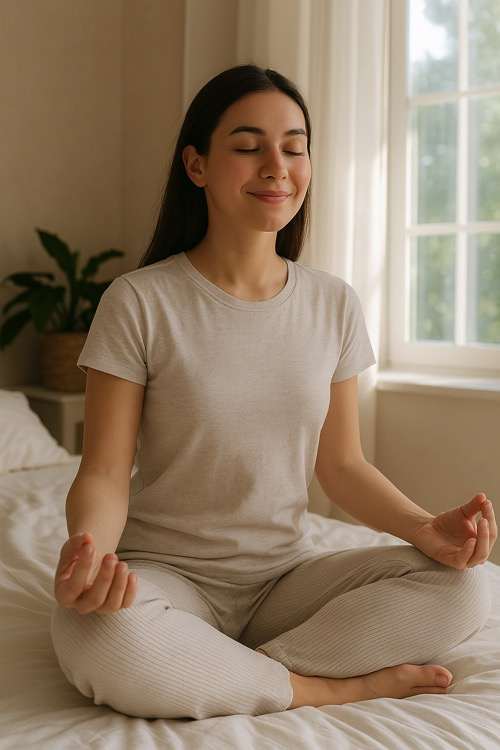
Exploring the Benefits of Mind-Body Yoga for Holistic Wellness
Mind-body yoga is more than just a fitness trend; it’s a holistic practice connecting the physical body with the mind and spirit. This

Starting a meditation practice can feel overwhelming, especially if you’re new to it. Many people face common challenges that can make it hard to stick with meditation. But don’t worry! This guide will help you tackle those roadblocks head-on. Whether it’s finding time, staying focused, or dealing with self-doubt, you can overcome these hurdles and enjoy the benefits of meditation. Let’s explore some practical tips to help you get started and keep going!
Set aside a specific time each day for meditation, even if it’s just a few minutes.
Use guided meditations to help you stay focused and present during your practice.
Create a calm space for meditation by minimizing distractions and finding a comfortable position.
Acknowledge that feeling unsure or imperfect is normal; celebrate your progress, no matter how small.
Connect with others who meditate to share experiences and support each other in your journeys.

It’s a common hurdle: squeezing meditation into an already packed schedule. You might think, “I’m too busy to meditate!” But even a few minutes can make a difference. The key is to find creative ways to integrate it into your day. It’s about making meditation a non-negotiable part of your routine, just like brushing your teeth. Let’s explore some strategies to help you find the time you need.
The best way to ensure you meditate is to schedule it. Think of it as an appointment with yourself. Pick a time that works consistently, whether it’s first thing in the morning, during your lunch break, or before bed. Consistency is key. Try to meditate at the same time every day. This helps build a habit. If you’re a morning person, set your alarm 10 minutes earlier. If evenings are better, make it part of your wind-down routine. Even weekends should stick to the schedule. This way, meditation becomes a habit rather than a chore.
Life gets hectic, and some days, finding a big chunk of time is impossible. That’s okay! Meditation doesn’t have to be an hour-long affair. Even five or ten minutes can be beneficial. Think of these short sessions as mini-resets throughout your day. You can do them anywhere: on your commute (if you’re not driving!), during a coffee break, or even in the bathroom. The point is to squeeze in moments of calm whenever you can. These short bursts can still provide a sense of peace and help you manage stress.
It’s easy to put yourself last on the list, but your well-being is essential. Think of meditation not as a luxury, but as a necessity. It’s an investment in your mental and emotional health. When you prioritize meditation, you’re better equipped to handle stress, focus on tasks, and be present in your relationships. It’s about recognizing that taking care of yourself allows you to take better care of everything else. Start by identifying activities you can cut back on – maybe less time on social media or watching TV – and use that time for meditation. Remember, prioritizing meditation is prioritizing yourself.
Meditation is not about escaping life; it’s about being present for it. By making time for meditation, you’re not just adding another task to your to-do list; you’re creating space for clarity, peace, and well-being in your life.
It’s super common to struggle with focus when you’re first starting out with meditation. Your mind is going to wander – that’s just what minds do. The trick is not to beat yourself up about it, but to gently guide your attention back. Think of it like training a puppy; you wouldn’t yell at it for not understanding immediately, right? Same goes for your brain.
One of the most basic, but effective, techniques is focusing on your breath. Feel the air going in and out of your nostrils, or the rise and fall of your chest. When you notice your mind drifting off to what you’re having for dinner or that awkward thing you said last week, just acknowledge the thought and bring your attention back to your breath. It’s all about the gentle redirection. Another thing you can try is body scan meditation, where you systematically bring awareness to different parts of your body, noticing any sensations without judgment. This can really anchor you in the present moment.
Sometimes, it helps to have a little extra help, and that’s where guided meditations come in. There are tons of apps and online resources that offer guided meditations for everything from stress reduction to better sleep. A guide can provide a focal point for your attention, making it easier to stay present. It’s like having a meditation buddy who’s always there to keep you on track. I personally like the ones that use nature sounds; they’re super calming. Give it a shot; you might be surprised how much easier it is to focus when someone is gently guiding you along.
Before you even sit down to meditate, take a moment to set an intention. What do you hope to get out of this session? Are you looking to reduce stress, cultivate gratitude, or simply be more present? Having a clear intention can act as a compass, guiding you back whenever your mind starts to wander. Write it down if that helps! It doesn’t have to be anything grand or complicated; even something as simple as “I intend to be present for the next five minutes” can make a difference.
Think of setting an intention like setting a destination in your GPS. It doesn’t mean you won’t encounter any detours along the way, but it gives you a clear direction to head towards. And if you do get lost, you can always recalibrate and get back on track.
It’s hard to quiet your mind when your surroundings are chaotic. Think of your meditation space as a sanctuary – a place where you can truly unwind and focus inward. It doesn’t need to be perfect, but a little effort in setting the stage can make a big difference. Let’s look at how you can create an environment that supports your meditation practice.
Finding the right spot is key. It doesn’t have to be a dedicated room; a corner of your bedroom, a quiet spot in your garden, or even your favorite armchair can work. The important thing is that it’s a place where you feel safe, comfortable, and relatively undisturbed. Consider these factors:
Natural Light: If possible, choose a space with some natural light. Sunlight can have a positive impact on your mood and energy levels.
Temperature: Make sure the temperature is comfortable. Too hot or too cold can be distracting.
Air Quality: Good ventilation is important. Open a window or use an air purifier to ensure the air is fresh.
Distractions are the enemy of a peaceful meditation. Before you start, take a few minutes to minimize potential interruptions. This might involve:
Turning off your phone or putting it on silent.
Informing family members or housemates that you need some quiet time.
Closing windows to block out external noise.
Using earplugs or noise-canceling headphones if necessary.
Remember, the goal is to create a space where you can fully immerse yourself in the present moment without being pulled away by external stimuli. It’s about creating a buffer between you and the outside world.
Your physical comfort is crucial for a successful meditation. You don’t want aches and pains to distract you from your practice. Experiment with different postures to find what works best for you. Here are a few options:
Sitting: Sit on a cushion or chair with your back straight but not stiff. You can sit cross-legged or with your feet flat on the floor.
Lying Down: If you’re feeling tired or have physical limitations, lying down is perfectly acceptable. Just be mindful that you don’t fall asleep!
Walking: Walking meditation involves focusing on the sensation of your feet making contact with the ground as you walk slowly and mindfully. This can be a great option if you find it difficult to sit still. Consider outdoor meditation for a refreshing experience.
No matter which posture you choose, make sure your body is relaxed and supported. Use cushions, blankets, or other props to help you find a comfortable position. The more comfortable you are, the easier it will be to focus on your breath and quiet your mind.
Self-doubt can be a real buzzkill when you’re trying to get into meditation. It’s that nagging voice that tells you you’re not doing it right, or that you’re just not the “meditation type.” But here’s the thing: everyone experiences self-doubt at some point, especially when starting something new. The key is to recognize it, understand where it’s coming from, and develop strategies to move past it. It’s like learning any new skill – there will be bumps in the road, but with patience and the right approach, you can totally get there. Don’t let those pesky thoughts hold you back from experiencing the benefits of meditation. You got this!
One of the biggest sources of self-doubt comes from believing common myths about meditation. Like, you might think you need to completely empty your mind, or that you have to sit perfectly still for hours. That’s just not true! Meditation is more about gently guiding your attention and being present in the moment. It’s not about achieving some impossible state of mind. Also, some people think that if they’re not feeling super zen after every session, they’re failing. But the benefits of meditation are often subtle and cumulative. It’s about the journey, not just the destination. Understanding these misconceptions can really help ease some of that initial self-doubt. You might even want to explore techniques to overcome fears and self-doubt.
Okay, so you’re not going to have perfect meditation sessions every time. Sometimes your mind will wander, sometimes you’ll feel restless, and sometimes you’ll just not be into it. And that’s totally okay! The important thing is to not beat yourself up about it. Embrace the imperfection and just keep showing up. Each time you sit down to meditate, you’re building a habit and strengthening your ability to be present. Think of it like this:
Every session is a learning opportunity. What did you notice about your thoughts? How did your body feel?
There’s no such thing as a “bad” meditation. Even if you were distracted the whole time, you still took the time to sit and try.
Be kind to yourself. Talk to yourself the way you would talk to a friend who’s struggling.
It’s all about progress, not perfection. The more you practice, the easier it will become to let go of expectations and just be present with whatever arises.
It’s easy to get discouraged if you’re only focusing on the big picture. Instead, try to celebrate the small wins along the way. Did you manage to meditate for five minutes without getting completely sidetracked? Awesome! Did you notice a moment of calm during a stressful day? That’s a win too! Keeping track of these small victories can help boost your confidence and keep you motivated. Maybe keep a journal and jot down a quick note after each session. Over time, you’ll start to see how far you’ve come, and that can be a powerful antidote to self-doubt. You can also try guided meditations for extra support.
It’s totally normal to feel a bit unsure when you’re starting something new, and meditation is no different. Maybe you think it’s not for you, or that you won’t be able to do it right. These feelings are common, and they shouldn’t stop you from exploring the potential benefits of meditation. Let’s look at some ways to get past those initial hesitations and give meditation a real try.
Don’t feel like you need to jump into advanced meditation practices right away. Begin with something super simple, like focusing on your breath for just a few minutes. There are tons of easy beginner meditation techniques out there that require very little effort or experience. You can try:
Following a guided meditation script.
Focusing on the sensation of your feet on the ground.
Simply noticing the sounds around you without judgment.
The key is to start small and build from there. You don’t need to sit for an hour or clear your mind completely on your first try. Just a few minutes of simple practice can make a big difference.
Meditation isn’t one-size-fits-all. There are many different styles, and what works for one person might not work for another. If you try one type of meditation and don’t enjoy it, don’t give up! Experiment with different approaches until you find something that resonates with you. Some popular styles include:
Mindfulness meditation
Loving-kindness meditation
Transcendental Meditation
Walking meditation
Each style has its own unique focus and techniques, so take some time to explore and see what feels right for you. You might even find that you enjoy different styles at different times, depending on your mood and needs. Don’t be afraid to go with your gut and try something new.
It can be really helpful to connect with other people who are also interested in meditation. Joining a meditation group or finding a meditation buddy can provide you with support, encouragement, and accountability. You can share your experiences, ask questions, and learn from others. Look for local meditation groups in your area, or join an online community. There are also many apps and websites that offer guided meditations and connect you with other meditators. Having a community can make the journey feel less daunting and more enjoyable.
It’s easy to start something new, but keeping it going? That’s the real challenge. Meditation is no different. You might feel super motivated at first, ready to meditate every day, but life happens. Don’t worry, it’s totally normal. The trick is to build meditation into your life in a way that sticks.
Don’t aim for an hour-long session every day if you’re just starting out. That’s a recipe for burnout. Instead, start small. Really small. Five minutes a day is better than zero minutes a day. The key is to set goals you can actually achieve. Once you’ve nailed five minutes, you can gradually increase the time. Think of it like building a muscle – you wouldn’t start with the heaviest weight, would you?
It can be really helpful to see how far you’ve come. There are tons of ways to track your meditation practice. You could use a simple calendar and mark off each day you meditate. Or, there are apps specifically designed for tracking meditation. Find what works for you. Seeing your progress can be a great motivator. It’s like, “Hey, I’ve meditated every day for the past two weeks! I don’t want to break the streak!”
Think about ways you can weave meditation into your existing routine. Maybe you meditate for five minutes before you check your email in the morning. Or perhaps you do a quick breathing exercise while you’re waiting for your coffee to brew. The more you can connect meditation to things you already do, the easier it will be to remember and stick with it. Consistency is key, and making it a habit is how you get there.
Remember, it’s not about being perfect. It’s about showing up for yourself, even when you don’t feel like it. Every little bit counts, and over time, those little bits add up to something big.
Here are some ideas to get you started:
Meditate during your commute (if you’re not driving, of course!).
Take a few deep breaths before a stressful meeting.
Use a meditation app during your lunch break.
It’s normal to face emotional hurdles when you start meditating. Sometimes, sitting quietly brings up feelings you’ve been avoiding. Don’t worry; this is a common part of the process. The key is to approach these emotions with kindness and understanding. It’s like gently tending a garden – you wouldn’t yank out a weed, but carefully loosen the soil around it.
First, it’s important to identify what’s coming up for you. Are you feeling anxious, sad, or frustrated? Maybe you’re experiencing a sense of restlessness or boredom. Whatever it is, acknowledge it without judgment. Think of these emotions as visitors. You don’t have to invite them to stay, but you can acknowledge their presence. Often, just naming the emotion can lessen its intensity. For example, you might notice, “Oh, I’m feeling a lot of anxiety right now,” instead of getting swept away by it. Recognizing these blocks is the first step to consistent meditation.
Self-compassion is crucial when dealing with difficult emotions. It means treating yourself with the same kindness and understanding you would offer a friend. If you’re struggling, try these:
Acknowledge your suffering: “This is hard, and it’s okay that I’m struggling.”
Remember common humanity: “Other people feel this way too. I’m not alone.”
Offer yourself kindness: “May I be kind to myself in this moment.”
Self-compassion isn’t about letting yourself off the hook. It’s about acknowledging your pain and offering yourself support so you can grow and heal. It’s about creating a safe space within yourself to process difficult emotions.
Journaling can be a powerful way to process your emotions. After your meditation session, take a few minutes to write down what came up for you. Don’t censor yourself; just let your thoughts flow onto the page. You might want to consider these prompts:
What emotions did I notice during my meditation?
What thoughts were associated with those emotions?
What physical sensations did I experience?
What can I learn from this experience?
Reviewing your journal entries over time can help you identify patterns and gain deeper insights into your emotional landscape. It’s a way to track your progress and guided meditation journey.
Facing emotional resistance can be tough, but it’s a normal part of growth. When you feel stuck, try to understand what’s holding you back. Acknowledge your feelings and give yourself permission to feel them. Remember, it’s okay to take small steps. If you want more tips on overcoming these challenges, visit our website for helpful resources and support!
In the end, remember that meditation is a journey, not a race. It’s totally normal to hit bumps along the way, whether it’s finding time, staying focused, or creating the right environment. The key is to be kind to yourself and keep trying. Every little effort counts. Maybe start with just a few minutes each day and gradually build from there. Try different techniques until you find what feels right for you. With patience and practice, you’ll find that meditation can become a comforting part of your daily routine. So take a deep breath, let go of any pressure, and enjoy the process of discovering your own path to mindfulness.
The best time to meditate is when you can be consistent. Many people find early morning or just before bed works well.
As a beginner, you can start with just 5 to 10 minutes a day. You can gradually increase the time as you get more comfortable.
It’s normal to have trouble focusing. Try using guided meditations or focusing on your breath to help keep your mind on track.
Choose a spot in your home that is calm and free from distractions. You can use cushions or blankets to make it comfortable.
Remember, meditation is a skill that takes time to develop. It’s okay to feel unsure; just keep practicing and be patient with yourself.
Yes! There are many styles, like mindfulness, loving-kindness, or movement-based practices. Experiment to find what feels best for you.

Mind-body yoga is more than just a fitness trend; it’s a holistic practice connecting the physical body with the mind and spirit. This

In today’s fast-paced digital world, it’s easy to feel overwhelmed by the constant stream of information and notifications. This phenomenon, known as digital

In 2025, prioritizing mental wellness is crucial for navigating modern life’s challenges. Maintaining a healthy mind is essential, and this article offers practical strategies

In today’s tech-driven world, it’s easy to feel overwhelmed and drained. Constant notifications and screen time can leave us feeling mentally exhausted. That’s why

Exploring Mindful Movement Yoga: A Journey to Inner Peace and Wellness

Cognitive Behavioral Therapy (CBT) is a widely recognized therapeutic approach for addressing various mental health challenges.

HealthyRelaxation.com uses cookies and similar technologies to enhance your browsing experience, provide personalized content, and analyze our traffic.
By clicking “Accept”, you consent to the processing of your data, including unique identifiers and browsing activity, for these purposes. You may choose to customize your settings or withdraw consent at any time. Please note that certain site features may be affected if you decline.
Feel better. Live calmer. Unplug with purpose.